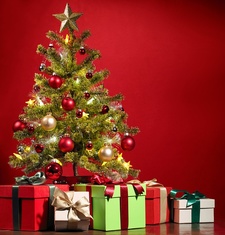
5 Christmas Traditions You Probably Didn't Know The True Meaning Of
Last updated: Thursday December 10th, 2020
Report this blog
5 Christmas Traditions You Probably didn't know the true meaning of
You may or may not know some of these traditions
5. The Candy Cane
Meaning: The white of the cane can represent the purity of Jesus Christ and the red stripes are for the blood he shed when he died on the cross. The peppermint flavor can represent the hyssop plant that was used for purifying in the Bible.
Origin: Candy canes first date back to Germany in 1670 when a choirmaster at the Cologne Cathedral in Germany handed out "sugar sticks" among his young singers to keep them quiet during the Living Creche ceremony.
4. Santa Claus
Meaning: Santa Claus, also known as Father Christmas, Saint Nicholas, Saint Nick, Kris Kringle, or simply Santa, is a legendary character originating in Western Christian culture who is said to bring gifts to the homes of well-behaved children on the night of Christmas Eve or during the early morning hours of Christmas Day and coal to naughty kids.
Origin: The legend of Santa Claus can be traced back hundreds of years to a monk named St. Nicholas. It is believed that Nicholas was born sometime around 280 A.D. in Patara, near Myra in modern-day Turkey. Over the course of many years, Nicholas's popularity spread and he became known as the protector of children and sailors. He lost his parents at a young age and used his inheritance to help the poor and sick.
3. The Christmas Tree
Meaning: The evergreen fir tree has traditionally been used to celebrate winter festivals (pagan and Christian) for thousands of years. Pagans used branches of it to decorate their homes during the winter solstice, as it made them think of the spring to come. Christians use it as a sign of everlasting life with God. It also became a symbol of Christ, being triangular in shape it represents the trinity, and from there came the idea that the tree should be a symbol of Christ and new life.
Origin: Germany is credited with starting the Christmas tree tradition as we now know it in the 16th century when devout Christians brought decorated trees into their homes. It is a widely held belief that Martin Luther, the 16th-century Protestant reformer, first added lighted candles to a tree.
2. Mistletoe
Meaning: Mistletoe is a plant that grows on range of trees including willow, apple and oak trees. The tradition of hanging it in the house goes back to the times of the ancient Druids. It is supposed to possess mystical powers which bring good luck to the household and wards off evil spirits. Kissing under sprigs of mistletoe is a well-known holiday tradition, but this little plant's history as a symbolic herb dates back thousands of years, when someone declared mistletoe a symbol of love and vowed to plant a kiss on all those who passed beneath it. It became a well-known tradition.
Origin: The plant's romantic overtones most likely started with the Celtic Druids of the 1st century A.D. Because mistletoe could blossom even during the frozen winter, the Druids came to view it as a sacred symbol of vivacity, and they administered it to humans and animals alike in the hope of restoring fertility.
1. Poinsettias
Meaning: While considered by the ancient Aztecs to be symbols of purity, in today's language of flowers, red, white or pink poinsettias, the December birth flower, symbolize good cheer and success and are said to bring wishes of mirth and celebration.
Origin: Poinsettia plants are native to Central America, especially an area of southern Mexico known as 'Taxco del Alarcon' where they flower during the winter. The ancient Aztecs called them 'cuetlaxochitl'. They are also found in the wild indeciduous tropical forest at moderate elevations from southern Sinaloa down the entire Pacific coast of Mexico to Chiapas and Guatemala. They are also found in the interior of Mexico in the hot, seasonally dry forests of Gurerro and Oxaca.
Thank You for reading my blog
Comment if I should do a part 2, maybe with weird christmas traditions.
